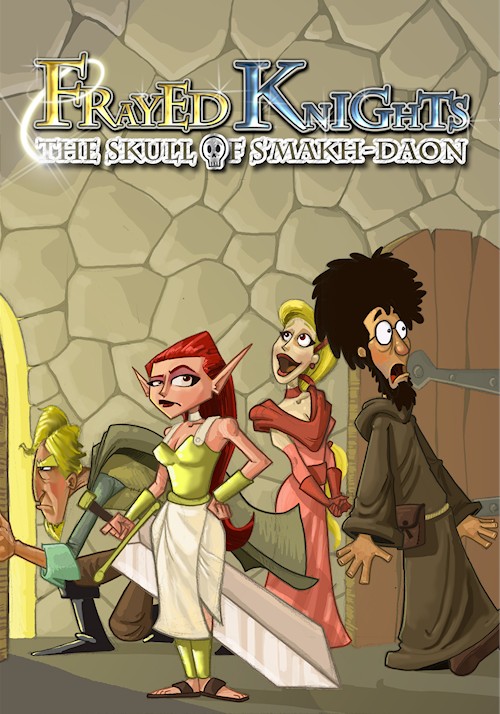Frayed Knights: The Skull of S'makh-Daon Review
-
Category: ReviewsHits: 21633

Article Index
Page 2 of 5
The underpinnings of Frayed Knights' character development are pretty much standard for the CRPG genre, and overall are quite robust. There is no class system to speak of, and while the four characters (who you can't customize the names or appearances of) start out roughly adhering to certain archetypes, you can very quickly change them to fit just about whatever role you want. On a basic level, characters are governed by five attributes: Might, Reflexes, Brains, Charm, and Luck, and these are fairly self-explanatory. Might operates pretty much as you'd expect, increasing damage dealt, Health, and allowing characters to use heavier weapons and armor; Reflexes increases chances to hit, improves defense (or dodging), and increases speed in combat; Brains improves the effectiveness of spells and Endurance; Charm improves Endurance and priest spells, and has a minor effect during certain conversations; and luck governs resistance to spells, chance to avoid traps, as well as a number of feats. In addition to these primary attributes, there's two derived attributes: Health, which shouldn't need explaining, as well as Endurance, which is effectively mana and stamina, though it's consumed for most tasks, including standard attacks, feats and spellcasting. Last, there's a couple more attributes, such as Speed, and Accuracy, which are derived from and enhanced by equipment and spells. On top of this, Frayed Knights features an extensive number of different proficiencies, spellcasting feats, enhancements (passive bonuses), and skills (active feats). All of these, in addition to the primary attributes, can be increased using character points awarded on level up (done on a per-character basis); you'll get two points every odd-numbered level, and one every even level, and while the vast majority of upgrades cost a single point, some requires two, especially as you get into the higher levels. To be frank, Frayed Knights has some of the most satisfying leveling-up I've had the pleasure of in a long time. The game's level cap is a mere 13, and I finished the game at level 12 after doing absolutely every single side-quest and exploring every dungeon, so you'll have to really work for each level-up, not to mention that the number of points you'll have to spend is fairly limited. This means that you'll frequently be making some very tough decisions about what to upgrade. I found myself mostly leaning towards passive upgrades as I made my way through the game, but the sheer number (approximately 80 in total) and the overall usefulness of all of them meant that I found myself agonizing even after I knew exactly what I wanted. I haven't looked forward to leveling up, and then had so much trouble making up my mind about it, since the original Fallout, and I mean that in the best possible way.
The actual combat setup is similarly functional and well thought out, and avoids getting bogged down in gimmicks. Battles are turn-based, with characters taking turns based on their Speed (which can occasionally lead to characters receiving extra turns in succession). Terrain has no bearing on how combat plays out, but positioning within party formation does. By default, short weapons (i.e. daggers) can only attack one "space" ahead, while medium weapons (swords, axes, clubs) can attack two spaces, but with a penalty (which can be removed with a specific feat), and long weapons (spears, halberds, etc.) can reach three spaces ahead, but again, with penalties. This means that, for example, a dagger-wielding party member will only be able to attack enemies immediately in front of it, while one wielding a spear will be able to attack those at the back of an enemy group. This means, on a basic level, keeping your spellcasters in the back and melee fighters in the front, but it can be exploited in order to reap greater advantages. For instance, targeting spells at enemy spellcasters in the back of their squads will make fights go by much more quickly, while putting enemies in the rear to sleep can put them out of the fight until the front ranks are down, and using poison can drain enemies in the back before they can attack you. It's simple, becomes quite intuitive after a few battles, and most importantly, works well to add some subtle depth and make combat a bit more than just spamming the best attacks over and over.
Beyond that, there's a couple more staples of turn-based CRPGs, searching for secrets and disarming traps/picking locks. Searching in the game is a simple matter of pressing the hotkey X, or clicking the search button in the user interface. Depending on whether or not there's a secret nearby, you'll receive a distance indicator of 4 to 1, with 4 being far away and 1 being nearby. Although in theory this sounds great, in practice, searching is a rather repetitive task, and since it passes turns, often you'll find yourself beset by enemies in the process, which can become a bit annoying, especially later in the game when the frequency of those encounters increases. Searching is required for some side-quests and to find some of the game's more powerful loot, but at least usually you'll be given some indication of where to search.
Traps and locks, meanwhile, are detected based on the Luck attribute, and are disarmed via a mini-game using your most skilled party member. This mini-game is quite barebones and mostly consists of using various inventory items to disarm individual trap or lock components, and also opens your party to potential random encounters, though there are often no ill effects for failing. My only real complaint with this system is that there's no way to search for traps - detecting them is a one-time thing and there's rarely an indication that you'll have to deal with a trap until you've tripped it. You'd expect it to tie into the search mechanic in some way, but it doesn't.


